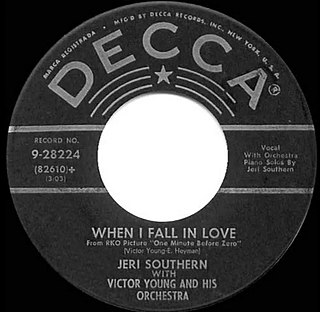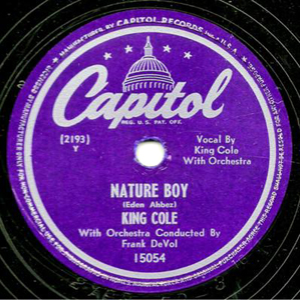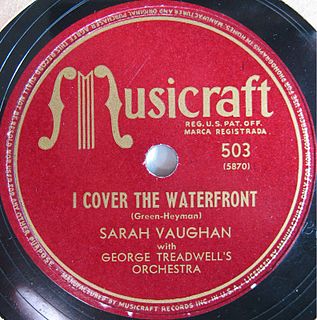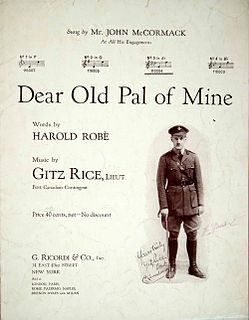Related Research Articles

Nathaniel Adams Coles, known professionally as Nat King Cole, was an American singer, jazz pianist, songwriter, and actor. He recorded over 100 songs that became hits on the pop charts. His trio was the model for small jazz ensembles that followed. Cole also acted in films and on television and performed on Broadway. He was the first African-American man to host an American television series. He was the father of singer Natalie Cole (1950–2015).

Ol' Yellow Eyes Is Back is an album by Brent Spiner, best known for his role as Data in the American television series Star Trek: The Next Generation, first released in June 1991. The title is a parodic reference both to Frank Sinatra's Ol' Blue Eyes Is Back and the Data character, whose eyes are golden yellow. On the album, Spiner is backed by the orchestra from that series as he sings a number of old pop standards, mostly from the 1930s and 1940s.
Mack Gordon was an American composer and lyricist for the stage and film. He was nominated for the best original song Oscar nine times in 11 years, including five consecutive years between 1940 and 1944, and won the award once, for "You'll Never Know". That song has proved among his most enduring, and remains popular in films and television commercials to this day. "At Last" is another of his best-known songs.
Ruth Lowe was a Canadian pianist and songwriter. She composed the first Billboard top 80 song "I'll Never Smile Again".

"When I Fall in Love" is a popular song, written by Victor Young (music) and Edward Heyman (lyrics). It was introduced in the film One Minute to Zero. Jeri Southern sang on the first recording released in April 1952 with the song's composer, Victor Young, handling the arranging and conducting duties. The song has become a standard, with many artists recording it; the first hit version was sung by Doris Day released in July 1952.

"Nature Boy" is a song first recorded by American jazz singer Nat King Cole. It was released on March 29, 1948, as a single by Capitol Records, and later appeared on the album, The Nat King Cole Story. The song was written in 1947 by eden ahbez and is partly autobiographical. It is a tribute to ahbez's mentor Bill Pester, who had originally introduced him to Naturmensch and Lebensreform philosophies, which ahbez practiced. When Cole was performing in 1947 at the Lincoln Theater, ahbez wanted to present the song to him, but was ignored. He left the copy with Cole's valet, and from him the singer came to know of "Nature Boy". After receiving appreciation for his performance of the song, Cole wanted to record it but needed consent from the writer. Eventually, he tracked down ahbez.
"Don't Take Your Love from Me" is a popular song written by Henry Nemo and published in 1941. Mildred Bailey first recorded this song in 1940 before publication. It was introduced that year by singer Joan Brooks.
William D. Carey was an American singer, songwriter, actor, and author.
Raymond Blanning Egan was a Canadian-American songwriter of popular music. Many of his songs have appeared in films and musical theatre. He often collaborated with composer Richard A. Whiting.

"I Cover the Waterfront" is a 1933 popular song and jazz standard composed by Johnny Green with lyrics by Edward Heyman. The song was inspired by Max Miller's 1932 best-selling novel, I Cover the Waterfront.

Eugenie Baird was an American big-band singer.
"Oh! What it Seemed to Be" is a song composed by Bennie Benjamin, George Weiss and Frankie Carle. The song was most popular in 1946, and was taken to number 1 that year by both Frank Sinatra and the Frankie Carle orchestra, the latter with Marjorie Hughes on vocals.
"My Adobe Hacienda" is a song composed by Louise Massey and Lee Penny. It first became popular in 1941 with Massey's recorded version, where it placed at #23. The song was most popular in 1947 when Eddy Howard took the song to #2. That year the song was also recorded by Kenny Baker (#16), the Dinning Sisters (#9), and the Billy Williams Quartet (#13). Massey's original recording was re-released, and this time attained a chart position of #16. Between May and June 1947, the song appeared on Your Hit Parade for three weeks. Billboard listed it as 1947's 12th best seller in sheet music. Art Kassel released the song as a Vogue picture disc.
One Alone is a popular song composed by Sigmund Romberg with lyrics by Oscar Hammerstein II and Otto Harbach for their operetta The Desert Song. It was introduced by Robert Halliday.

Dear Old Pal of Mine is a World War I song written by Harold Robe and Gitz Rice. The song was first published in 1916 by G. Ricordi & Co. in New York, NY.
"At Sundown " is a fox-trot style song written by Walter Donaldson. The song was published in 1927 by Leo. Feist Inc. in New York, NY. This hit song reportedly sold more than two million disks in various versions in the late 1920s. It has been used in several movie musicals including Glorifying the American Girl, This Is the Life, Music for Millions, Margie, The Fabulous Dorseys, Love Me or Leave Me, and The Joker Is Wild.
"Blue bell: March Song and Chorus" is a march style song composed by Theodore F. Morse and written by Edward Madden. The song was published in 1904 by F.B. Haviland Pub. Co., in New York, NY.The cover, illustrated by Rose Starmer, depicts a soldier and a young woman. The song was recorded and popularized by Byron Harland and Frank Stanley, the Haydn Quartet, and Henry Burr.
Harold A. Robe (1881-1946) was an early 20th century American lyricist. He is known for penning several popular songs, most notably Dear Old Pal of Mine. For many of his songs, Robe collaborated with composer Gitz Rice. Other notable songs include, Because You're Here, Mary Lee , and Never Swap Horses When You're Crossing a Stream.
Lou Davis was an American songwriter, and author associated with Tin Pan Alley. He was also a businessman in the wholesale meat business. His primary musical collaborators were Abel Baer, Henry Busse, Harold Arlen, Henry Lange, and J. Fred Coots. Several of his most notable songs include "Hot Lips", "A Precious Little Thing Called Love", "Deep in the Arms of Love", "Here Comes My Ball and Chain", and "I'm Croonin' a Tune About June".

Send Me Away With A Smile is a World War I song written by Louis Weslyn and composed by Al Piantadosi. The song was first published in 1917 by Al. Piantadosi & Co., Inc. in New York, NY. The sheet music cover depicts a woman waving to a soldier from a fenced yard with an inset photo of Rita Gould.
References
- ↑ Tyler, Don (2007). Hit Songs, 1900-1955: American Popular Music of the Pre-Rock Era. Jefferson, North Carolina; London: McFarland & Company, Inc., Publishers. pp. 399, 487. ISBN 978-0-7864-2946-2 . Retrieved 8 April 2017.
- 1 2 Green, Stanley (1999). Hollywood Musicals Year by Year (2nd ed.). Milwaukee, Wisconsin: Hal Leonard Corporation. p. 123. ISBN 0-634-00765-3 . Retrieved 13 May 2017.
- ↑ Tyler, Don (2007). Hit Songs, 1900-1955: American Popular Music of the Pre-Rock Era. Jefferson, North Carolina; London: McFarland & Company, Inc., Publishers. p. 400. ISBN 978-0-7864-2946-2 . Retrieved 8 April 2017.
- ↑ Holden, Stephen (September 29, 1984). "Pop: Barbara Rankins Sings". The New York Times. Retrieved 21 February 2017.
- ↑ "My Heart Tells Me - Frank Sinatra | Song Info". AllMusic.com. AllMusic. Retrieved 20 February 2017.
- ↑ "My Heart Tells Me - Tony Bennett | Song Info". AllMusic.com. AllMusic. Retrieved 20 February 2017.
- ↑ "My Heart Tells Me - Nat King Cole | Song Info". AllMusic.com. AllMusic. Retrieved 20 February 2017.
- ↑ "My Heart Tells Me - Etta Jones | Song Info". AllMusic.com. AllMusic. Retrieved 20 February 2017.
- ↑ Makamson, Collin. "Glen Gray & Eugenie Baird, 'My Heart Tells Me' at #1". The National WWII Museum | New Orleans. The National WWII Museum . Retrieved 20 February 2017.
- ↑ Thomas, H. (July 21, 1997). Dance in the City. Houndmills, Hampshire; London: Macmillan Press Ltd. p. 191. ISBN 978-0-333-64961-9 . Retrieved 20 February 2017.